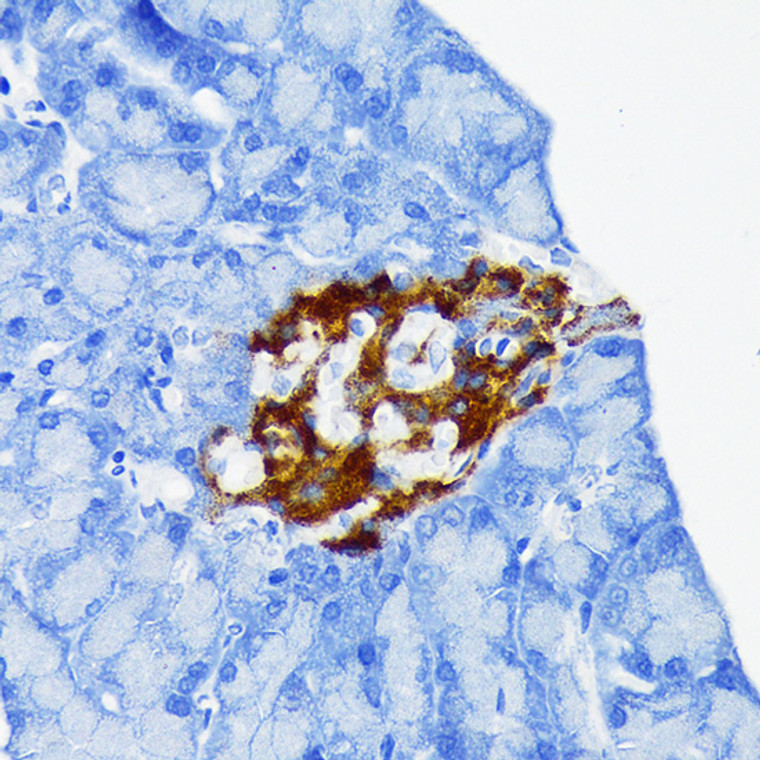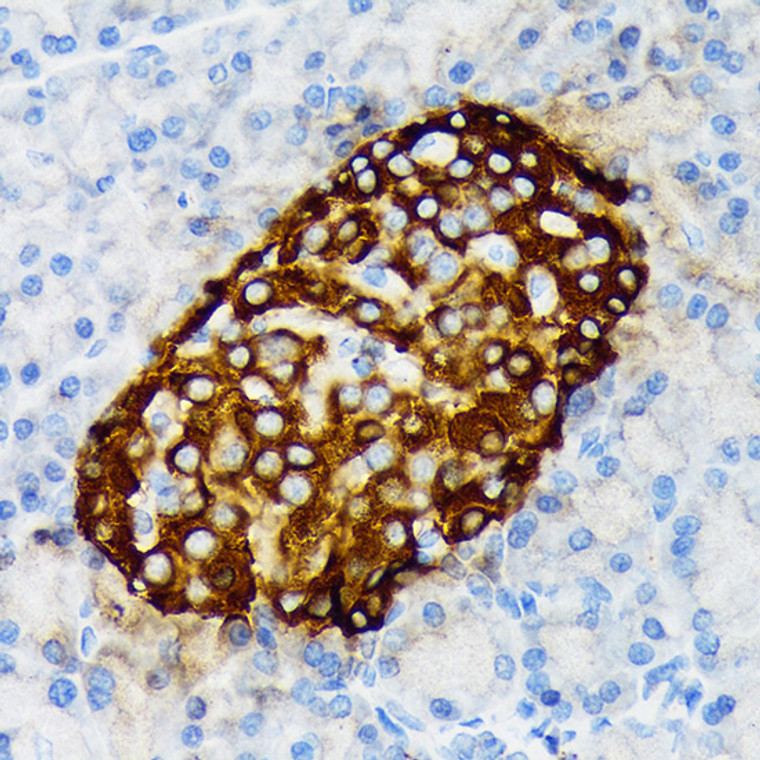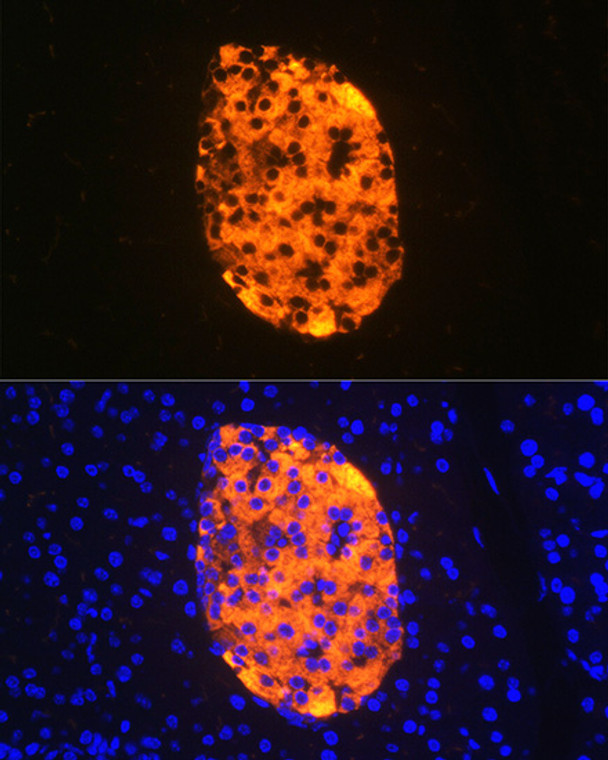| Host: |
Rabbit |
| Applications: |
WB/IHC/IF |
| Reactivity: |
Human/Mouse/Rat |
| Note: |
STRICTLY FOR FURTHER SCIENTIFIC RESEARCH USE ONLY (RUO). MUST NOT TO BE USED IN DIAGNOSTIC OR THERAPEUTIC APPLICATIONS. |
| Short Description: |
Rabbit monoclonal antibody anti-Chromogranin A (1-100) is suitable for use in Western Blot, Immunohistochemistry and Immunofluorescence research applications. |
| Clonality: |
Monoclonal |
| Clone ID: |
S6MR |
| Conjugation: |
Unconjugated |
| Isotype: |
IgG |
| Formulation: |
PBS with 0.02% Sodium Azide, 0.05% BSA, 50% Glycerol, pH7.3. |
| Purification: |
Affinity purification |
| Dilution Range: |
WB 1:500-1:1000IHC-P 1:50-1:200IF/ICC 1:50-1:200 |
| Storage Instruction: |
Store at-20°C for up to 1 year from the date of receipt, and avoid repeat freeze-thaw cycles. |
| Gene Symbol: |
CHGA |
| Gene ID: |
1113 |
| Uniprot ID: |
CMGA_HUMAN |
| Immunogen Region: |
1-100 |
| Immunogen: |
A synthetic peptide corresponding to a sequence within amino acids 1-100 of human Chromogranin A (P10645). |
| Immunogen Sequence: |
MRSAAVLALLLCAGQVTALP VNSPMNKGDTEVMKCIVEVI SDTLSKPSPMPVSQECFETL RGDERILSILRHQNLLKELQ DLALQGAKERAHQQKKHSGF |
| Tissue Specificity | Detected in cerebrospinal fluid (at protein level). GE-25: Found in the brain. |
| Post Translational Modifications | Sulfated on tyrosine residues and/or contains sulfated glycans. O-glycosylated with core 1 or possibly core 8 glycans. Contains chondroitin sulfate (CS).CS attachment is pH-dependent, being observed at mildly acidic conditions of pH 5 but not at neutral pH, and promotes self-assembly in vitro. Proteolytic processing gives rise to an additional longer form of catestatin (residues 358-390) which displays a less potent catecholamine release-inhibitory activity. Plasmin-mediated proteolytic processing can give rise to additional shorter and longer forms of catestatin peptides. |
| Function | Pancreastatin: Strongly inhibits glucose induced insulin release from the pancreas. Catestatin: Inhibits catecholamine release from chromaffin cells and noradrenergic neurons by acting as a non-competitive nicotinic cholinergic antagonist. Displays antibacterial activity against Gram-positive bacteria S.aureus and M.luteus, and Gram-negative bacteria E.coli and P.aeruginosa. Can induce mast cell migration, degranulation and production of cytokines and chemokines. Acts as a potent scavenger of free radicals in vitro. May play a role in the regulation of cardiac function and blood pressure. Serpinin: Regulates granule biogenesis in endocrine cells by up-regulating the transcription of protease nexin 1 (SERPINE2) via a cAMP-PKA-SP1 pathway. This leads to inhibition of granule protein degradation in the Golgi complex which in turn promotes granule formation. |
| Protein Name | Chromogranin-ACgaPituitary Secretory Protein ISp-I Cleaved Into - Vasostatin-1Vasostatin I - Vasostatin-2Vasostatin Ii - Ea-92 - Es-43 - Pancreastatin - Ss-18 - Wa-8 - We-14 - Lf-19 - CatestatinSl21 - Al-11 - Gv-19 - Gr-44 - Er-37 - Ge-25 - Serpinin-Rrg - Serpinin - P-Glu Serpinin Precursor |
| Database Links | Reactome: R-HSA-6803157 |
| Cellular Localisation | Serpinin: SecretedCytoplasmic VesicleSecretory VesiclePyroglutaminated Serpinin Localizes To Secretory VesicleNeuronal Dense Core VesicleSecretedAssociated With The Secretory Granule Membrane Through Direct Interaction To Scg3 That In Turn Binds To Cholesterol-Enriched Lipid Rafts In Intragranular ConditionsIn Pituitary GonadotropesLocated In Large Secretory Granules |
| Alternative Antibody Names | Anti-Chromogranin-A antibodyAnti-Cga antibodyAnti-Pituitary Secretory Protein I antibodyAnti-Sp-I Cleaved Into - Vasostatin-1 antibodyAnti-Vasostatin I - Vasostatin-2 antibodyAnti-Vasostatin Ii - Ea-92 - Es-43 - Pancreastatin - Ss-18 - Wa-8 - We-14 - Lf-19 - Catestatin antibodyAnti-Sl21 - Al-11 - Gv-19 - Gr-44 - Er-37 - Ge-25 - Serpinin-Rrg - Serpinin - P-Glu Serpinin Precursor antibodyAnti-CHGA antibody |
Information sourced from Uniprot.org
12 months for antibodies. 6 months for ELISA Kits. Please see website T&Cs for further guidance

















